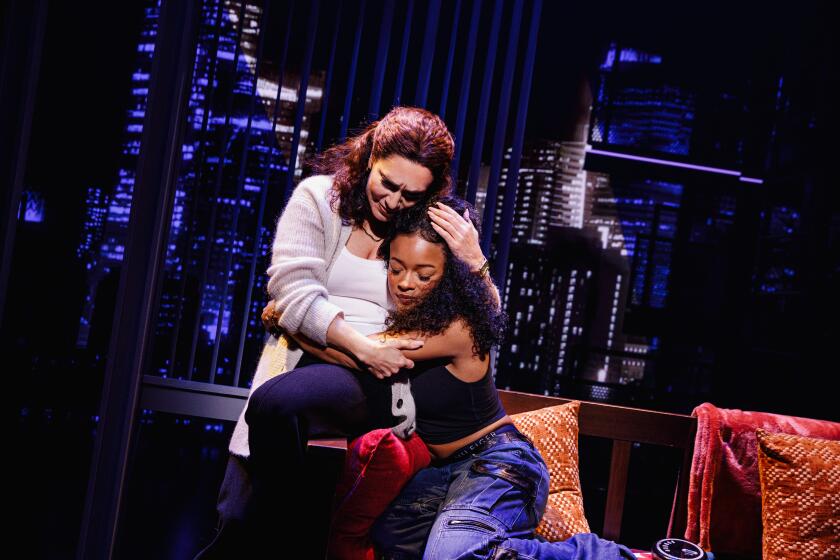Still Creating His Own Whirlwind
Standing alone on the stage of Royce Hall on Wednesday, Mikhail Baryshnikov was, as usual, putting himself at risk in a new way. Dressed Japanese-style in a tight tunic and voluminous trousers, he presented himself in the role of dance samurai, performing an unyieldingly tense 16-minute etude choreographed by Kabuki star Tamasaburo Bando V, a solo worlds away from Baryshnikov’s early incarnation as Russian ballet’s reigning virtuoso and also his more recent identity as modern dance’s roving ambassador.
Set to spare, astringent music by Rosen Tousha, “Dance With Three Drums and Flute” ushers Baryshnikov into the realm of traditional Japanese classicism and asks him to do the simplest things with all his weight, concentration and control. Slow walking, fast walking. Upraised foot to flat foot. A single rotation in place. Violent arm slashes while walking, the rest of the body kept still and composed as if nothing’s moving at all.
Even when Bando adds bursts of technical fireworks--a circuit of turns, asymmetrical jumps and cantilevered hopping steps--the challenge remains one of achieving a pinpoint focus and absolute selflessness. On the rest of this five-part White Oak Dance Project program at UCLA, Baryshnikov can interpret, dramatize and personalize choreography, even bask in the still remarkable technique left to him at age 51. But not here. Here the fascination involves watching a great dancer accept radically restricted options--something like hearing a great actor read the telephone book. In Japanese.
At the opposite extreme, Mark Morris’ florid sex-war showpiece “The Argument” can use all the acting and virtuosity that Baryshnikov commands. In April, when the Morris company danced it at the Irvine Barclay Theatre, the work enlisted three men and three women, depicting the troubled relationships of contrasting couples. However, the White Oak version is a quartet in which Baryshnikov, the lone male, assumes both Morris’ role and the one brilliantly danced in Irvine by Charlton Boyd, fusing them so that the same character moves from a volatile opening duet with Susan Shields to a more resigned partnership with Ruthlyn Salomons.
A piece about the constraints of monogamy thus becomes one about the constraints of promiscuity--still deftly in sync with Schumann’s “Five Pieces in Folk Style” for piano and cello but now something of a mess structurally. And, unfortunately for Morris, a concern for pristine formal structures distinguishes all the other choreographies on the program.
In Lucy Guerin’s “Soft Center,” for instance, alternating solos for Baryshnikov and Raquel Aedo lead to a twisty, limb-tangling partnership in which the vocabulary switches from linear balletic extensions to more liquid modern dance strategies. Sometimes Baryshnikov and Aedo melt from the former to the latter, as if pulled inward and downward to the region spelled out in the title. Elsewhere they stand very close to each other and exude so much intensity that your own soft center begins to melt. A music collage dominated by sound textures and the moody lighting of David Finn enhances the high-voltage energy flow.
In her doubly ironic “Two Lies,” Guerin stages one vignette in two different dance styles to music by David Chesworth. First come the Stepford Ballerinas: Aedo, Shields and Emmanuele Phuon locked into stiff, bobbly mock-classicism while wearing short, tutu-esque hoop skirts. A narrative emerges that shows Phuon eventually achieving a measure of humanity after rejecting Aedo and watching her fall lifeless to the floor. Blackout. The dancers then reappear in satiny slips to do a stretchier, slinkier, more flamboyant version of exactly the same sequence of events: a jazz/modern reinterpretation, if you like, equally artsy in its positional gambits and, as the title reminds you, equally fake.
So much for the pretentions and pitfalls of dance drama. Besides providing Guerin’s parody, White Oak generously supplies an alternative in its revival of Trisha Brown’s elegant, ingenious post-modern quintet “Glacial Decoy,” in which Emily Coates joins Salomons, Shields, Aedo and Phuon in front of four slide-screen panels. Designed by Robert Rauschenberg, the black-and-white image sequences on those screens create momentary perceptual shifts in the loose-limbed choreography. A close-up of a cow’s head makes the dancer in front of it look tiny, for instance, while that same dancer seems enormous in front of a distant cityscape. And, indeed, it takes a Rauschenberg to diminish dancers of this quality even for a moment; their excellence gives the evening major distinction all by itself.
Taped music accompanied everything except “Glacial Decoy” (danced in silence) and “The Argument,” which had the benefit of refined playing by cellist Alberto Parrini and pianist Nicolas Reveles.
*
* White Oak dances tonight and Saturday at 8, Sunday at 2 p.m., in Royce Hall on the UCLA campus in Westwood. $16-$75. (310) 825-2101.
More to Read
The biggest entertainment stories
Get our big stories about Hollywood, film, television, music, arts, culture and more right in your inbox as soon as they publish.
You may occasionally receive promotional content from the Los Angeles Times.






